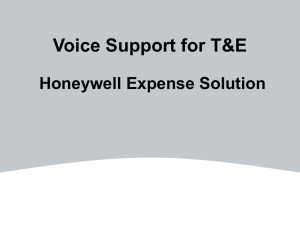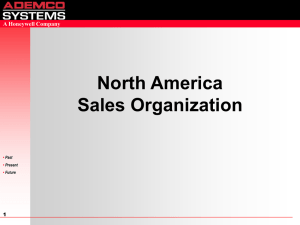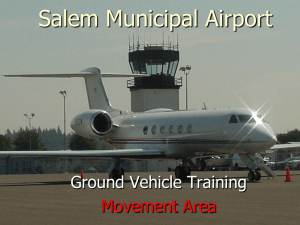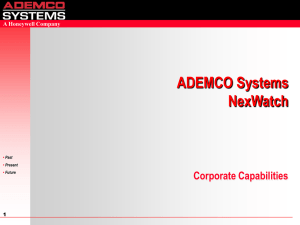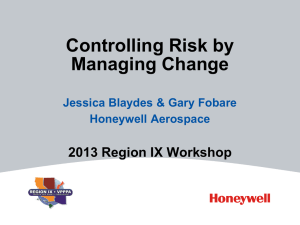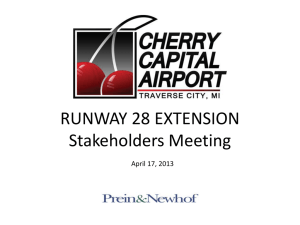honeywell airports business
advertisement
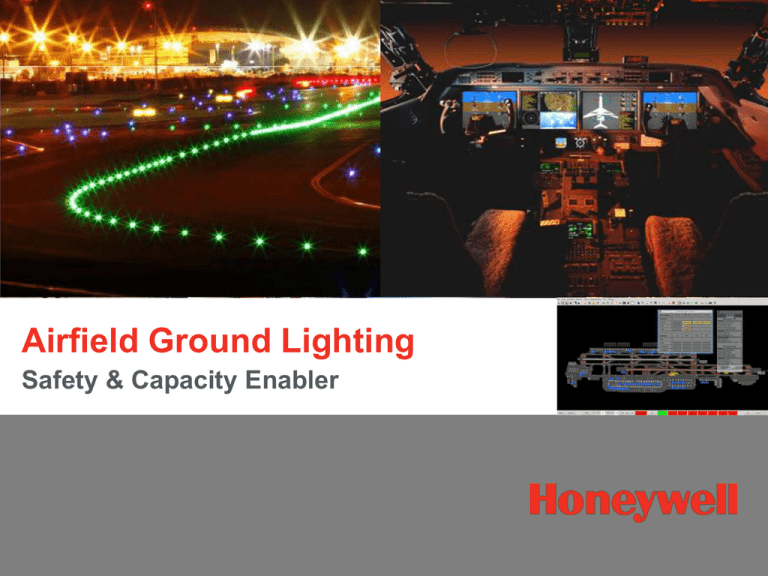
Airfield Ground Lighting Safety & Capacity Enabler Airport Eco-System Airport Customers • • • • Airport Elements • • • • Passengers Baggage Cargo Aircrafts Scen. 1 Runways Taxiways Apron Area Pax Terminal etc. Scen. 2 ………… Airport management is a complex business: many customers, providers, authorities and airport elements are involved and they do have conflicting interests. Scen. n Capacity Delays Level of Service Safety Security Emissions Noise Cost Airport managers have to evaluate the impact of the proposed solutions (scenarios) in several key performance areas, considering all the stakeholders. HONEYWELL CONFIDENTIAL - FOR INTERNAL USE ONLY 2 Inefficiencies in Ground Operations • Annually, at major airports in the United States (2009 ASPM) – Over 32 million minutes taxi-out delay (over unimpeded times) – Over 13 million minutes taxi-in delay (over unimpeded times) • Terminal-area volume responsible for 19% of delays at OEP 35 airports in 2009 – Aircraft in Europe are estimated to spend 1030% of their time taxiing [Airbus 2008] – A short/medium range A320 expends as much as 5-10% of its fuel on the ground [Airbus 2008] – Taxiing aircraft contribute to surface emissions as well as noise Increased Taxi Times, Fuel Burn, Emissions HONEYWELL CONFIDENTIAL - FOR INTERNAL USE ONLY 3 Needs of Airside Operations • A-CDM (Airport Collaborative Decision Making) • Unambiguous communications • Runway entrance control • No confusing lights • Less stop and go • Continuous taxi speed • Improved controller efficiency • Optimizing the use of available infrastructure • Robust A-SMGCS (Advance Surface Movement Guidance and Control Systems) Towards Optimized Ground Operations HONEYWELL CONFIDENTIAL - FOR INTERNAL USE ONLY 4 Total Airside Management Concept Total Operations Planner Traffic Monitor Pre-tactical 30min…3hr EMAN Tactical E2E Turnaround Monitor Situation Assessment Adhoc A-SMGCS Surveillance A-SMGCS Alerting AMAN SMAN DMAN 30min Monitor & TMAN Control Ground Guidance Onboard Guidance Now Airports Process EMAN – EnRoute Manager AMAN – Arr Manager SMAN – Surface Manager DMAN – Dep Manager ASMGCS – Advanced Surface Movement Guidance & Control System TMAN – Terminal Manager More Predictable & Efficient Operations Source: DLR HONEYWELL CONFIDENTIAL - FOR INTERNAL USE ONLY 5 Airport Performance Demand & Capacities Rwys, Txwys, Stands, Ramp Events according to one holistic Process Model, “LH263 landed”, “Last Pax Boarded”,…. Positions & Identities (Trajectories) of all Objects at the Airports e.g: Aircraft, Vehicles, Baggage, Cargo, Pax… Management Paradigm – From Objs. down to Ops & Procs. Level of Data Abstraction & Degree of Info Fusion Airside Impact Performance Targets Planned Flows for Rwys, Txwys, Stands, Ramp Airport Milestone Plan including E2E Process Target Times and Resource Usage Plan Planned trajectories for all Object at the Airport, Aircraft, Vehicles, Baggage, Cargo, Pax,….Nav – Support for Humans Performance Driven Management Source: DLR HONEYWELL CONFIDENTIAL - FOR INTERNAL USE ONLY 6 A-SMGCS Level as Defined by ICAO Carried out manually by Controller or Pilot / Driver A-SMGCS Level Carried out automatically by the System State of the art and recommended by Honeywell I II III IV V Surveillance Conflict Prediction and / or Detection Conflict Analysis Control Conflict Resolution Routing Painted Center Lines / TGS Fixed Center Line Lights Manually Switched Center Line Lights Guidance Automatically Switched Center Line Lights Onboard Guidance for Vehicles and Aircraft Optimized Ground Management Towards Optimized Ground Operations HONEYWELL CONFIDENTIAL - FOR INTERNAL USE ONLY 7 Delivery Safety, Capacity & Predictability Arrival Management (AMAN) Departure Management (DMAN) Surface Manager (SMAN) Surveillance Coop Objects Echoes, Replies, Broadcast Non Co-op Data Acquisition Sensor Fusion Surveillance ResultsVoice Communication Location, Identification Velocity, Heading Control of Lights & Signs Data Link to Co-op Objects Controller (Human Machine Interface) Warnings, Alerts Control (Monitoring, Alerting) Deviation from Planned Routes Planned Routes Conflict Resolution Routing and Planning Stop Bar or TXC Switching Guidance (Airfield Ground Lighting) Planned Routes Planning Rules and Parameters Airline Management Aerodrome Management HONEYWELL CONFIDENTIAL - FOR INTERNAL USE ONLY 8 Airside System Integration Architecture Total Airside Management System HONEYWELL CONFIDENTIAL - FOR INTERNAL USE ONLY 9 A-SMGCS Guidance with AGL Runway Functions (Safety) • Runway Protection – Time to touch down in an ‚Impending Arrival‘ arrow – Automatically switching on and locking of runway stop bars 30 sec before touch down – Show runway as occupied – Automatically switch off stop bars behind landing aircraft – Automatically switch off all stop bars, if aircraft slower than 80km/h • video scene – Smart Runway Protection Automatically switch on runway stop bar in front of aircraft for line up or crossing runway • video scene HONEYWELL CONFIDENTIAL - FOR INTERNAL USE ONLY 11 Taxiway Functions (Safety) • Aircraft separation (blocking) under CAT II/III • Under weather condition CAT II/III there is always one switched on stop bar between two aircrafts video scene Taxiing with Guidance by TXC and STB; Fog Picture Source: Atrics GmbH Individual Routing (Capacity) • Automatic Individual Routing • An optimal route (with relation to distance) is shown for each individual aircraft which has a stand or runway as destination • On a landing aircraft the runway exits are switched on into the direction of the destination • The route for each pilot is displayed with taxiway center line lights • The route ends at a switched on stop bar, an aircraft which drives in front, at the border of an area of responsibility, at the destination – video scene • If a pilot leaves his assigned route a ‚route deviation‘ alert is generated and as soon as possible a new optimal route is calculated and displayed to the pilot – video scene Individual & Collective Routes • Individual routes consider restricted areas (Safety) • Restricted areas are considered by individual routes video scene Taxiing with Guidance by TXC • Collective route for lot of aircrafts and displayed through the taxiway center line lights Picture Source: Atrics GmbH Key Benefits • Safety – 70% less incursions – Prevention of Runway Incursion with increased situational awareness for pilots • Efficiency & Environment – – – – Continuous Taxi Speeds – pilot maintain speed at intersections Reduced Handover delay – frequency is free from continuing taxi clearance Improved Traffic Sequencing – More time for planning by reduced workload Smooth Flow of Traffic – No route deviations or holding position overruns • Capacity – Up to 15% increase and corresponding reduce in delays – Increased LVP Taxiway throughput – Automated provisioning of longitudinal separation • Cost Effectiveness – Increased Controller Productivity – Handle Traffic growth without additional resources – Economic use of lighting equipment – Reduced lamp burning and replacements HONEYWELL CONFIDENTIAL - FOR INTERNAL USE ONLY 15 SESAR-JU “Follow the Green” Results • Increased FLIGHT CREW’S SITUATIONAL AWARENESS (>Factor 3) • Pilots see a potential in further improving SITUATIONAL AWARENESS by providing information on sequences and stop reasons, e.g. via GMG • Reduced FLIGHT CREW’S WORKLOAD (>50%) • Reduced FLIGHT CREW’S FRUSTRATION LEVEL (less ambiguity) • Very good USABILITY values (easy to understand and credible) • Increased SAFETY (4 route deviations in pre-SESAR, none with AGL) Source: SESAR AGL Validation HONEYWELL CONFIDENTIAL - FOR INTERNAL USE ONLY 16 SESAR-JU “Follow the Green” Results • Reduced TAXI TIMES (>37% in lowvis, >17% in CAVOK) • Increased TRAFFIC FLUENCY (> -65% stops in low-vis, > -40% in CAVOK) • Reduced FUEL BURN (>40% in lowvis, >18% in CAVOK) • Reduced EMISSIONS (>40% in lowvis, >20% in CAVOK) • Improved AIRPORT TAXI PERFORMANCE (~100% performance in low-vis) • Reduced MOVEMENT DELAY (>50% time reduction TXR to movement) • Reduced COMMUNICATION EFFORT (~50% reduction of R/T time) Source: SESAR AGL Validation HONEYWELL CONFIDENTIAL - FOR INTERNAL USE ONLY 17 Thank You For Your Attention, and remember: With 400 tons and 400 passengers that you are responsible for, you need somebody to lighten your way! 18 Today’s Honeywell
